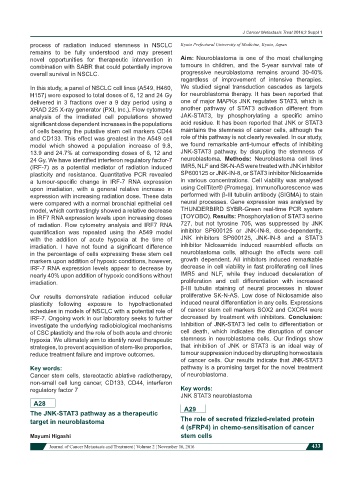Page 443 - Read Online
P. 443
J Cancer Metastasis Treat 2016;2 Suppl 1
process of radiation induced stemness in NSCLC Kyoto Prefectural University of Medicine, Kyoto, Japan
remains to be fully understood and may present
novel opportunities for therapeutic intervention in Aim: Neuroblastoma is one of the most challenging
combination with SABR that could potentially improve tumours in children, and the 5-year survival rate of
overall survival in NSCLC. progressive neuroblastoma remains around 30-40%
regardless of improvement of intensive therapies.
In this study, a panel of NSCLC cell lines (A549, H460, We studied signal transduction cascades as targets
H157) were exposed to total doses of 6, 12 and 24 Gy for neuroblastoma therapy. It has been reported that
delivered in 3 fractions over a 9 day period using a one of major MAPKs JNK regulates STAT3, which is
XRAD 225 X-ray generator (PXI, Inc.). Flow cytometry another pathway of STAT3 activation different from
analysis of the irradiated cell populations showed JAK-STAT3, by phosphorylating a specific amino
significant dose dependent increases in the populations acid residue. It has been reported that JNK or STAT3
of cells bearing the putative stem cell markers CD44 maintains the stemness of cancer cells, although the
and CD133. This effect was greatest in the A549 cell role of this pathway is not clearly revealed. In our study,
model which showed a population increase of 9.8, we found remarkable anti-tumour effects of inhibiting
13.9 and 24.7% at corresponding doses of 6, 12 and JNK-STAT3 pathway, by disrupting the stemness of
24 Gy. We have identified interferon regulatory factor-7 neuroblastoma. Methods: Neuroblastoma cell lines
(IRF-7) as a potential mediator of radiation induced IMR5, NLF and SK-N-AS were treated with JNK inhibitor
plasticity and resistance. Quantitative PCR revealed SP600125 or JNK-IN-8, or STAT3 inhibitor Niclosamide
a tumour-specific change in IRF-7 RNA expression in various concentrations. Cell viability was analysed
upon irradiation, with a general relative increase in using CellTiter® (Promega). Immunofluorescence was
expression with increasing radiation dose. These data performed with β-III tubulin antibody (SIGMA) to stain
were compared with a normal bronchial epithelial cell neural processes. Gene expression was analysed by
model, which contrastingly showed a relative decrease THUNDERBIRD SYBR-Green real-time PCR system
in IRF7 RNA expression levels upon increasing doses (TOYOBO). Results: Phosphorylation of STAT3 serine
of radiation. Flow cytometry analysis and IRF7 RNA 727, but not tyrosine 705, was suppressed by JNK
quantification was repeated using the A549 model inhibitor SP600125 or JNK-IN-8, dose-dependently.
with the addition of acute hypoxia at the time of JNK inhibitors SP600125, JNK-IN-8 and a STAT3
irradiation. I have not found a significant difference inhibitor Niclosamide induced resembled effects on
in the percentage of cells expressing these stem cell neuroblastoma cells, although the effects were cell
markers upon addition of hypoxic conditions, however, growth dependent. All inhibitors induced remarkable
IRF-7 RNA expression levels appear to decrease by decrease in cell viability in fast proliferating cell lines
nearly 40% upon addition of hypoxic conditions without IMR5 and NLF, while they induced deceleration of
irradiation. proliferation and cell differentiation with increased
β-III tubulin staining of neural processes in slower
Our results demonstrate radiation induced cellular proliferative SK-N-AS. Low dose of Niclosamide also
plasticity following exposure to hypofractionated induced neural differentiation in any cells. Expressions
schedules in models of NSCLC with a potential role of of cancer stem cell markers SOX2 and CXCR4 were
IRF-7. Ongoing work in our laboratory seeks to further decreased by treatment with inhibitors. Conclusion:
investigate the underlying radiobiological mechanisms Inhibition of JNK-STAT3 led cells to differentiation or
of CSC plasticity and the role of both acute and chronic cell death, which indicates the disruption of cancer
hypoxia. We ultimately aim to identify novel therapeutic stemness in neuroblastoma cells. Our findings show
strategies, to prevent acquisition of stem-like properties, that inhibition of JNK or STAT3 is an ideal way of
reduce treatment failure and improve outcomes. tumour suppression induced by disrupting homeostasis
of cancer cells. Our results indicate that JNK-STAT3
Key words: pathway is a promising target for the novel treatment
Cancer stem cells, stereotactic ablative radiotherapy, of neuroblastoma.
non-small cell lung cancer, CD133, CD44, interferon
regulatory factor 7 Key words:
JNK STAT3 neuroblastoma
A28
The JNK-STAT3 pathway as a therapeutic A29
target in neuroblastoma The role of secreted frizzled-related protein
4 (sFRP4) in chemo-sensitisation of cancer
Mayumi Higashi stem cells
Journal of Cancer Metastasis and Treatment ¦ Volume 2 ¦ November 16, 2016 433

